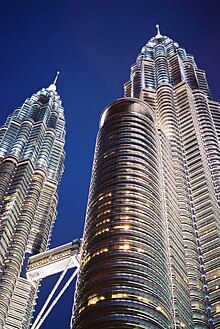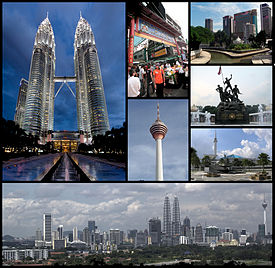Kuala Lumpur (translated as: "muddy confluence" or "muddy estuary"; pronounced /ˈkwɑːləlʊmˈpʊər/ in English; Malay [kwɑlɑlʊmpʊ], locally [kwɑləlʊmpɔ] or even [kɔlɔmpɔ] and often abbreviated as K.L.) is the capital and the largest city of Malaysia in terms of population. The city proper, making up an area of 244 km2 (94 sq mi), has an estimated population of 1.6 million in 2006.Greater Kuala Lumpur, also known as the Klang Valley, is an urban agglomeration of 7.2 million. It is the fastest growing metropolitan region in the country, in terms of population and economy.
Kuala Lumpur is the seat of the Parliament of Malaysia. The city was once home to the executive and judicial branches of the federal government, but they have since moved to Putrajaya starting in 1999. Some sections of the judiciary remain in the capital. The official residence of the Malaysian King, the Istana Negara, is also situated in Kuala Lumpur. Rated as an alpha world city, Kuala Lumpur is the cultural, financial and economic centre of Malaysia due to its position as the capital as well as being a primate city.
Kuala Lumpur is defined within the borders of the Federal Territory of Kuala Lumpur and is one of three Malaysian Federal Territories. It is an enclave within the state of Selangor, on the central west coast of Peninsular Malaysia.] Residents of the city are colloquially known as KLites.
Since the 1990s, the city has played host to many international sporting, political and cultural events including the 1998 Commonwealth Games and the Formula One World Championship. In addition, Kuala Lumpur is home to the tallest twin buildings in the world, the Petronas Twin Towers, which have become a symbol of Malaysia's development.
Architecture
Architecture in Kuala Lumpur
The architecture of Kuala Lumpur is a blend of old colonial influences, Asian traditions, Malay Islamic inspirations, modern, and postmodern architecture mix Being a relatively young city compared with other Southeast Asian capitals such as Bangkok, Jakarta and Manila, most of Kuala Lumpur's colonial buildings were built toward the end of the 19th and early 20th centuries. These buildings have Moorish, Tudor, Neo-Gothic or Grecian-Spanish style or architecture. Most of the styling has been modified to use local resources and acclimatised to the local climate, which is hot and humid all year around.
Prior to the Second World War, many shophouses, usually two storeys with functional shops on the ground floor and separate residential spaces upstairs, were built around the old city centre. These shop-houses drew inspiration from Straits Chinese and European traditions. Some of these shophouses have made way for new developments but there are still many standing today around Medan Pasar (Old Market Square), Chinatown, Jalan Tuanku Abdul Rahman, Jalan Doraisamy, Bukit Bintang and Tengkat Tong Shin areas.
Independence coupled with the rapid economic growth from the 1970s to the 1990s and with Islam being the official religion in the country, has resulted in the construction of buildings with a more local and Islamic flavour arise around the city. Many of these buildings derive their design from traditional Malay items such as the songkok and the keris. Some of these buildings have Islamic geometric motifs integrated with the designs of the building, signifying Islamic restriction on imitating nature through drawings.[78] Examples of these buildings are Menara Telekom, Menara Maybank, Dayabumi Complex, and the Islamic Center.[79] Some buildings such as the Islamic Arts Museum Malaysia and National Planetarium have been built to masquerade as a place of worship, complete with dome and minaret, when in fact it is a place of science and knowledge. The 452-metre (1,483 ft) tall Petronas Twin Towers are the tallest twin buildings in the world. They were designed to resemble motifs found in Islamic art.[81]
Late modern and postmodern architecture began to appear in the late-1990s and early-2000s. With the economic development, old buildings such as Bok House have been razed to make way for new ones. Buildings with all-glass shells exist throughout the city, with the most prominent examples being the Petronas Twin Towers and Kuala Lumpur Convention Centre. As of, September 2010 Kuala Lumpur's central business district today has shifted around the Kuala Lumpur city centre (KLCC) where many new and tall buildings with modern and postmodern architecture fill the skyline.
| Federal Territory of Kuala Lumpur Wilayah Persekutuan Kuala Lumpur كوالا لومڤور 吉隆坡联邦直辖区 கோலாலம்பூர் | |||
|---|---|---|---|
| — City — | |||
| Clockwise from top left: Petronas Twin Towers, Petaling Street, Masjid Jamek and Gombak/Klang river confluence, Tugu Negara, Masjid Negara, skyline of KL. Center: KL Tower | |||
| |||
| Nickname(s): KL, Garden City of Lights | |||
| Motto: Maju dan Makmur (English: Progress and Prosper) | |||
| | |||
| Coordinates: 3°8′51″N 101°41′36″E / 3.1475°N 101.69333°E | |||
| Country | Malaysia | ||
| State | Federal Territory | ||
| Establishment | 1849 | ||
| Granted city status | 1972 | ||
| Granted Federal Territory | 1974 | ||
| Government | |||
| - Mayor (Datuk Bandar) | Dato' Ahmad Fuad Ismail[1] From 14 December 2008 | ||
| Area | |||
| - City | 243.65 km2 (95.18 sq mi) | ||
| Elevation | 21.95 m (72 ft) | ||
| Population (2009)[2] | |||
| - City | 1,809,699 (1st) | ||
| - Density | 7,388/km2 (18,912/sq mi) | ||
| - Metro | 7.2 million | ||
| - Demonym | KL-ite / Kuala Lumpurian | ||
| Human Development Index | |||
| - HDI (2010) | 0.796 (very high) (2nd) | ||
| Time zone | MST (UTC+8) | ||
| - Summer (DST) | Not observed (UTC+8) | ||
| Postal code | 50xxx to 60xxx 68xxx | ||
| Mean solar time | UTC + 06:46:48 | ||
| National calling code | 03 | ||
| License plate prefix | Wxx (for all vehicles except taxis) HWx (for taxis only) | ||
| ISO 3166-2 | MY-14 | ||
| Website | Official Kuala Lumpur Website | ||









No comments:
Post a Comment